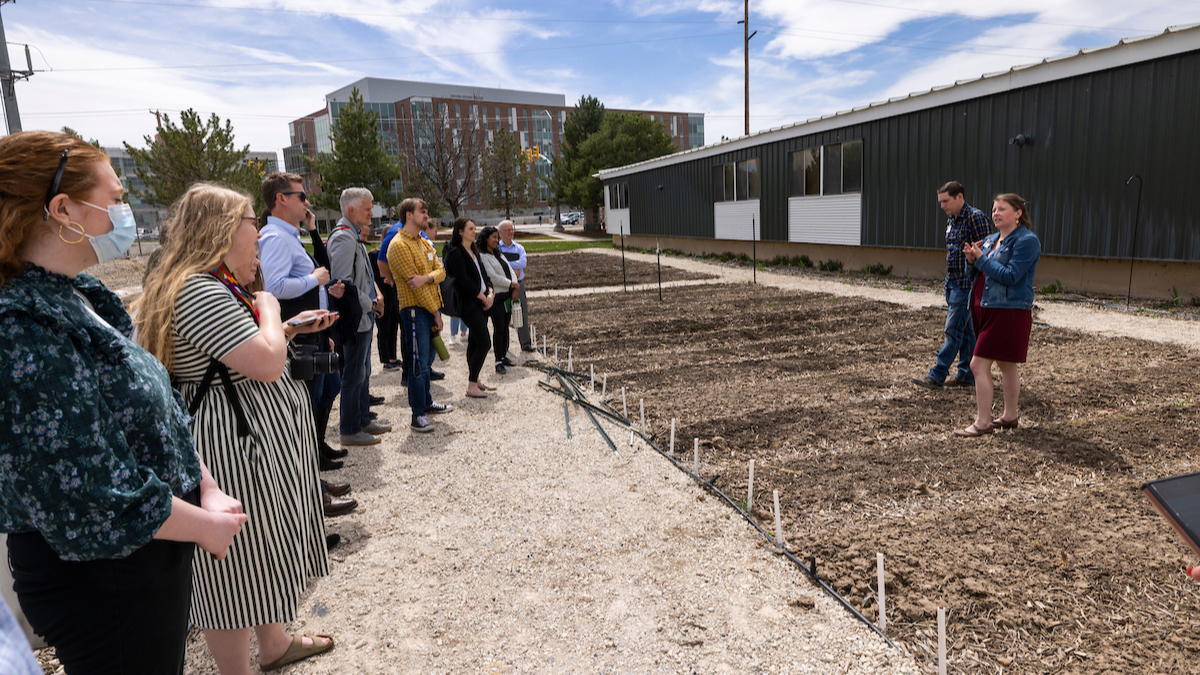Experts in engineering, technology, policy, social entrepreneurship, and sustainability gathered April 12 in the Scott C. Keller Building for the second annual UVU Sustainability Summit to discuss challenges and solutions in the fields of sustainability and environmental consciousness.

Utah Valley University (UVU) is not only green in color, but in action.
Experts in engineering, technology, policy, social entrepreneurship, and sustainability gathered April 12 in the Scott C. Keller Building for the second annual UVU Sustainability Summit to discuss challenges and solutions in the fields of sustainability and environmental consciousness.
Keynote speaker and Dell Technologies Senior Higher Education Strategist Danielle Rourke addressed the importance of sustainability in the tech industry and the measures her company is taking to be wise global stewards.
“The decisions we make today can help mitigate future climate impacts,” Rourke said. “The need for innovative technology and solutions is incredibly important and it will only continue to get important as our resources get more scarce. We want to reduce emissions not only across our own company, but also across the planet and helping those who use our products also reduce their footprint on the environment.”
Breakout sessions were held following Rourke’s remarks, including panel discussions that addressed topics such as citizen engagement, sustainability in business, and the learning opportunities for sustainability at UVU.
Panelist and Director of the UVU Capitol Reef Field Station (CRFS), Dr. Michael T. Stevens, spoke about the CRFS and its role in helping students, faculty, and staff learn more about nature and the positive impact of eco-friendly behavior.
“[CRFS] visitors produce 89% less trash than typical Americans,” he said. “A typical American produces 4.6 pounds of trash per day, and at the field station our visitors are only producing about a half a pound per day. In terms of water, it's 54% less. The typical American uses 30 gallons of water per day…our visitors are using about half, 13.7 gallons. We educate and we keep track and report our resource usage at CRFS. The synergy of working and living together brings out the best in people.”
Panelist and Center for Social Impact Outreach Program Director Kaile Akina-Schiess addressed how UVU practices the power of community engagement to address social problems like sustainability.
“We don't believe that there's any singular moment, action, or individual that's going to create long sustainable social change,” she said. “We believe that it takes calculated and engaged mobilizing and organizing.”
Following the breakout sessions, participants embarked on a campus sustainability tour that examined UVU operations and the efforts made in energy efficiency, water and landscaping, transportation and air quality, waste reduction and recycling, and community building. The tour began in the Keller Building and ended in the UVU GRIT Community Garden.
“I'm really encouraged by the turnout by the excitement of this summit,” sustainability coordinator Sarah Bateman said. “Sometimes conversations about sustainability and the environment — for some audiences — have historically posed a challenge at times. As we continue these conversations and talk about shared values, and again that collaborative approach to innovation and caretaking of each other and the planet, it's just encouraging to see more and more people showing up and recognizing how they can engage in a way that's meaningful to them, and beneficial for all in that collaborative environment.
Learn more about sustainability at UVU.
Energy
The Scott C. Keller Building is a Utah High-Performance Buildings Standard (HPBS) building.
The new Scott M. Smith engineering building will also be built to be HPBS and will have an all-electric HVAC system.
Elektron Solar Project –When online, Elektron solar panels will provide (net) ~ 93% of UVU’s energy from the sun.
Water
UVU plans to reduce 5% of sod space by 2024. Approximately 10 acres of xeriscape freeway berm, islands, parking strips, improvement projects, and the couple cliffs are currently in design.
Plans are in the works to reduce irrigation another by 10%. UVU went from using approximately 120 million to 80 million gallons a year in the past few years.
Transportation/Air quality
Anyone with a UVUID has a free UTA pass. UVU supports nearby housing projects so more students are able to walk or take transit.
Waste
UVU is implementing a food-waste-to-energy pilot program. Instead of sending food waste to the landfill where it releases methane into the atmosphere, UVU will send some of its food waste to an anaerobic digester (Wasatch Resource Recovery, in N. Salt Lake) that captures the methane and is then used to heat homes in the community.